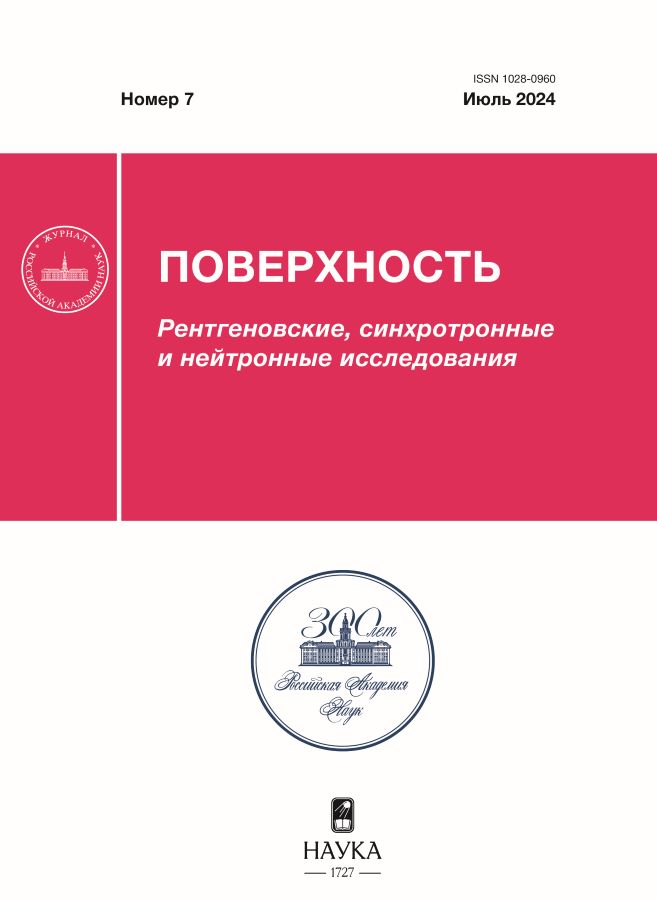Ballistic сonductivity of gold nanotubes
- Authors: Sozykina E.R.1, Sozykin S.A.1, Beskachko V.P.1
-
Affiliations:
- South Ural State University
- Issue: No 7 (2024)
- Pages: 51-57
- Section: Articles
- URL: https://freezetech.ru/1028-0960/article/view/664793
- DOI: https://doi.org/10.31857/S1028096024070074
- EDN: https://elibrary.ru/EVGSYX
- ID: 664793
Cite item
Abstract
The paper presents the results of a theoretical study of the electronic structure and electrical conductivity with chirality indices (4, 0), (5, 0), (6, 0), (7, 0), (4, 4), and (5, 5). The simulations were performed using the density functional theory and the method of nonequilibrium Green’s functions. The exchange-correlation functional Perdue-Burke-Ernzerhof and two-exponential basis set were used. We demonstrated the importance of polarized basis sets for the study of electrical properties. Analysis of the results showed that the transmission functions of the studied nanotubes depends on the structure of the SWGNTs in a complex way, but, in general, it increase with increasing diameter. The dependence of the transmission function on the electron energy does not allow us to speak a priori about the linearity of the current–voltage characteristic of gold nanotubes within a certain finite voltage range. In addition to defect-free single-walled gold nanotubes, gold nanotubes of different diameters with a vacancy were also studied. This allowed us to evaluate the effect of such a defect on the atomic structure and electrical conductivity of the single-walled gold nanotubes. It was demonstrated that the conductivity drop can vary within a wide range, correlating with changes in the atomic structure.
Full Text
About the authors
E. R. Sozykina
South Ural State University
Author for correspondence.
Email: sozykinaer@susu.ru
Russian Federation, Chelyabinsk
S. A. Sozykin
South Ural State University
Email: sozykinaer@susu.ru
Russian Federation, Chelyabinsk
V. P. Beskachko
South Ural State University
Email: sozykinaer@susu.ru
Russian Federation, Chelyabinsk
References
- Bachmann M.D., Sharpe A.L., Baker G., Barnard A.W., Putzke C., Scaffidi T., Nandi N., McGuinness P., Zhakina E., Moravec M., Khim S., Köni M., Goldhaber-Gordon D., Bonn D.A., Mackenzie A.P., Moll P. J.W. // Nat. Phys. 2022. V. 18. № 7. P. 819. https://www.doi.org/10.1038/s41567-022-01570-7
- Banszerus L., Frohn B., Fabian T., Somanchi S., Epping A., Müller M., Neumaier D., Watanabe K., Taniguchi T., Libisch F., Beschoten B., Hassler F., Stampfer C. // Phys. Rev. Lett. 2020. V. 124. № 17. P. 177701. https://www.doi.org/10.1103/PhysRevLett.124.177701
- De Cecco A., Prudkovskiy V.S., Wander D., Rini Ganguly R., Claire Berger C., de Heer W.A., Courtois H., Winkelmann C.B. // Nano Lett. 2020. V. 20. № 5. P. 3786. https://www.doi.org/10.1021/acs.nanolett.0c00838
- Kondo Y., Takayanagi K. // Phys. Rev. Lett. 1997. V. 79. P. 3455. https://www.doi.org/10.1103/PhysRevLett.79.3455
- Oshima Y., Onga K., Takayanagi A. // Phys. Rev. Lett. 2003. V. 91. P. 205503. https://www.doi.org/10.1103/PhysRevLett.91.205503
- Takayanagi K., Kondo Y., Ohnishi H. // JSAP Int. 2001. V. 3. № 3. P. 3.
- Landauer R. // Phyl. Mag. 1970. V. 21. № 172. P. 863. https://www.doi.org/10.1080/14786437008238472
- Del Valle M., Tejedor C., Cuniberti G. // Phys. Rev. B. 2006. V. 74. P. 045408. https://www.doi.org/10.1103/PhysRevB.74.045408
- Manrique D. Zs., Cserti J., Lambert C.J. // Phys. Rev. B. 2010. V. 81. № 7. P. 073103. https://www.doi.org/10.1103/PhysRevB.81.073103
- Yang X., Dong J. // Phys. Rev. B. 2005. V. 71. P. 233403. https://www.doi.org/10.1103/PhysRevB.71.233403
- Cai Y., Zhou M., Zeng M., Zhang C., Feng Y.P. // Nanotechnology. 2011. V. 22. № 21. P. 215702. https://www.doi.org/10.1088/0957-4484/22/21/215702
- Sozykin S.A., Beskachko V.P. // Physica E. 2020. V. 115. P. 113686. https://www.doi.org/10.1016/j.physe.2019.113686
- Senger R., Dag, S. Ciraci S. // Phys. Rev. Lett. 2004. V. 93. P. 196807. https://www.doi.org/10.1103/PhysRevLett.93.196807
- Дьячков Е.П., Дьячков П.Н. // Журнал неорганической химии. 2021. Т. 66. № 11. С. 1568. https://www.doi.org/10.31857/S0044457X21110040
- Краснов Д.О., Кольцова Э.М. // Успехи в химии и химической технологии. 2022. Т. 36. № 11. С. 60.
- García A., Papior N.R., Akhtar A., Artacho E., Blum V., Bosoni E., Brandimarte P., Brandbyge M., Cerdá J.I., Corsetti F., Cuadrado R., Dikan V., Ferrer J., Gale J., García-Fernández P., García-Suárez V.M., García S., Huhs G., Illera S., Korytár R., Koval P., Lebedeva I., Lin L., López-Tarifa P., Mayo S.G., Mohr S., Ordejón P., Postnikov A., Pouillon Y., Pruneda M., Robles R., Sánchez-Portal D., Soler J.M., Ullah R., Yu V. Wen-zhe, Junquera J. // J. Chem. Phys.2020. V. 152. № 20. P. 204108. https://www.doi.org/10.1063/5.0005077
- Lee J., Kim H.S., Kim Y.H. // AdV. Sci. 2020. V. 7. № 16. P. 2001038. https://www.doi.org/10.1002/advs.202001038
- Soler J.M., Artacho E., Gale D.J., García A., Junquera J., Ordejón P., Sánchez-Portal D. // J. Phys. Condens. Matter. 2002. V. 14. № 11. P. 2745. https://www.doi.org/10.1088/0953-8984/14/11/302
- Isshiki Y., Li D., Kiguchi M., Nishino T., Pauly F., Fujii S. // ACS Appl. Mater. Interfaces. 2022. V. 14. № 9. P. 11919. https://www.doi.org/10.1021/acsami.1c24096
- Zhu Y., Chen C., Wu S., Cheng R., Cheng L., Zhou W.-L. // J. Appl. Phys. 2020. V. 128. № 6. P. 064302. https://www.doi.org/10.1063/5.0009406
- Abadir G.B., Walus K., Pulfrey D.L. // J. Comput. Electron. 2009. V. 8. № 1. P. 1. https://www.doi.org/10.1007/s10825-009-0263-5
- Agrawal S., Srivastava A., Kaushal G. // IOP Conf. Ser. Mater. Sci. Eng. 2022. V. 1221. № 1. P. 012053. https://www.doi.org/10.1088/1757-899X/1221/1/012053
- Wang Y., Ma Y., Ni E., Jiang Y., Li H. // Chem. Phys. Chem. 2022. V. 23. № 17. P. e202200177. https://www.doi.org/10.1002/cphc.202200177
Supplementary files

















